
|

|

|

|

|

|
| Home | Manuals | Supplies | Search | Consult | Contact | Testing | Service |
|
(Other Test Rolls that we offer are found here.)
The Mel-O-Dee Test Roll #1149 is quite a bit different from the Player-Care Test Roll, which is why we had it produced. While the Mel-O-Dee roll has the normal Note Repetition Test, a short Scale Uniformity Test, and a Capacity Test, which are found on almost all regular test rolls, the Mel-O-Dee roll focuses more on Musicality than any of the other test rolls that we've encountered. Unlike other test rolls, the Mel-O-Dee test roll uses the Auto-Sustain (or automatic pedal) feature a lot! It also plays musical sequences that challenge the piano dampers. In a number of places, as you can hear in the MP3 audio file of the portion of the roll that follows the Note Repetition Test, Scale Uniformity Test, and Capacity Test, the roll is designed to find out if the Melody can be heard during times when lots of other notes are being played. Admittedly, it takes somewhat of a trained ear, but what it shows the user is whether or not the automatic pedal is properly adjusted and working smartly. It also tells the user if the dampers are functioning well. If they aren't, the music will be muddled and unpleasant to the ear. Unfortunately, the company that perforated the roll for Player-Care doesn't have the equipment to print wording on the roll. For that reason, the following pictures from the original roll are provided below. For easy reading, below each picture is the text that's found on the roll. You can also click on the image to see a full sized image. (Images are slightly skewed due to the angle at which the pictures were taken.) 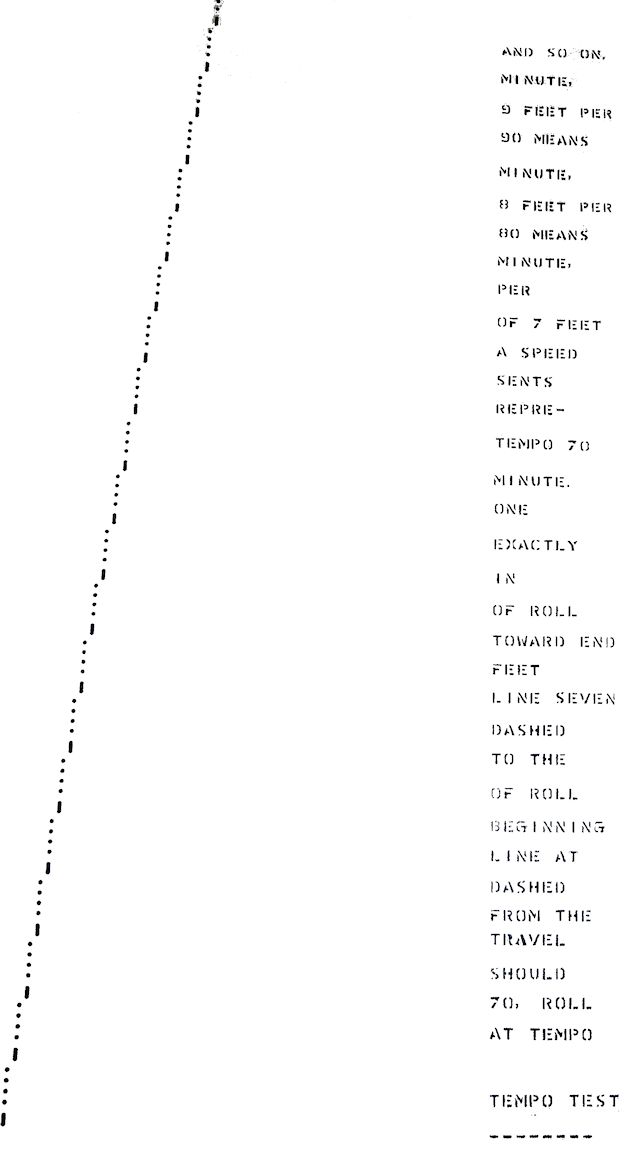 AT TEMPO 70, ROLL SHOULD TRAVEL FROM THE DASHED LINE AT BEGINNING OF ROLL TO THE DASHED LINE SEVEN FEET TOWARD END OF ROLL IN EXACTLY ONE MINUTE. TEMPO 70 REPRESENTS A SPEED OF 7 FEET PER MINUTE, 80 MEANS 8 FEET PER MINUTE, 90 MEANS 9 FEET PER MINUTE, AND SO ON.
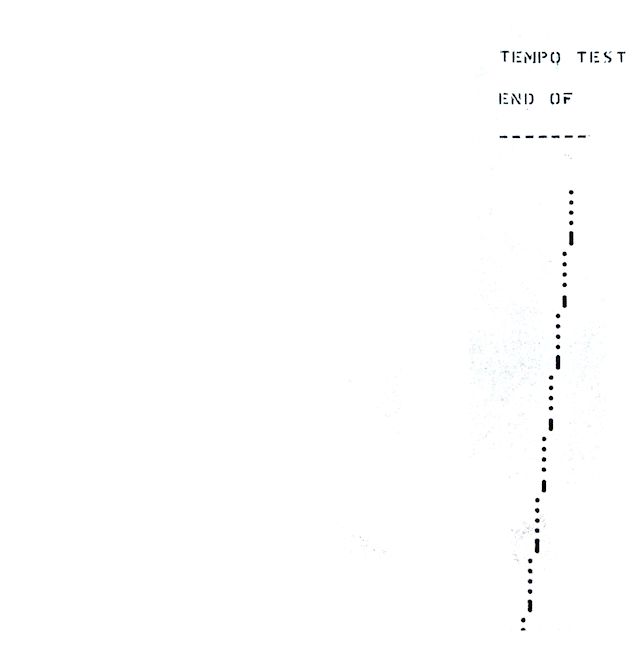 END OF TEMPO TEST If it's not clear, it should be mentioned that the Tempo/Note Repetition Test starts just as the first Bass Note (C2) is played, and ends a split second after the last Treble Note (A8) is played. Also, this portion of the test roll obviously plays all but the first three notes in the bass register (A1, Bb1, and B1), and the last three notes in the treble register (Bb8, B8, and C9). As to why Mel-O-Dee elected not to include these notes, we can only conjecture that it had to do with the invention of the after-market automatic rewind device that was sold by Player Piano Co, in Wichita, KS in the very early 60's. That device commonly used either notes A1, Bb1, B8, or C9 to trigger the device into operation.
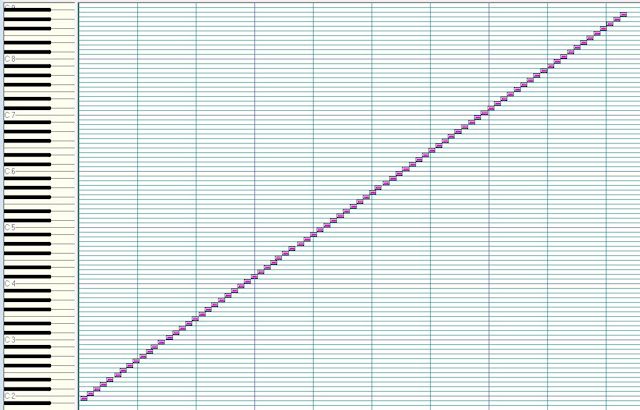 There is no writing on this portion of the roll. So, we didn't take a picture. This is a screen-shot of the MIDI file. The purpose of this test is to help determine if there are any notes that are noticeably louder or softer than the rest. The only other thing of interest about this run of notes is that it begins with note B1 instead of C2, as in the Tempo/Note Repetition Test.
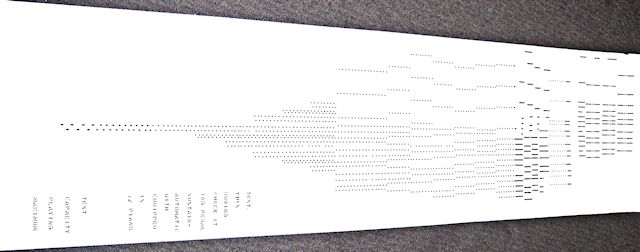 MAXIMUM PLAYING CAPACITY TEST IF PIANO IS EQUIPPED WITH AUTOMATIC SUSTAINING PEDAL, CHECK IT DURING THIS TEST. It should be noted that this test only takes about 30 seconds to complete. Also, if you examine the location of the sustain perforations very closely (in the full size image), you see that they all end a split second 'before' the playing of the next chord. So, the purpose of these perforations is to insure that the automatic sustaining device is turning OFF very smartly. If it doesn't, the first chord won't stop sounding when the next chord begins. Here's what it should sound like -click here. If the chords seem 'blur' into each other, the automatic sustain pedal isn't turning 'off' fast enough, and needs to be adjusted or repaired.
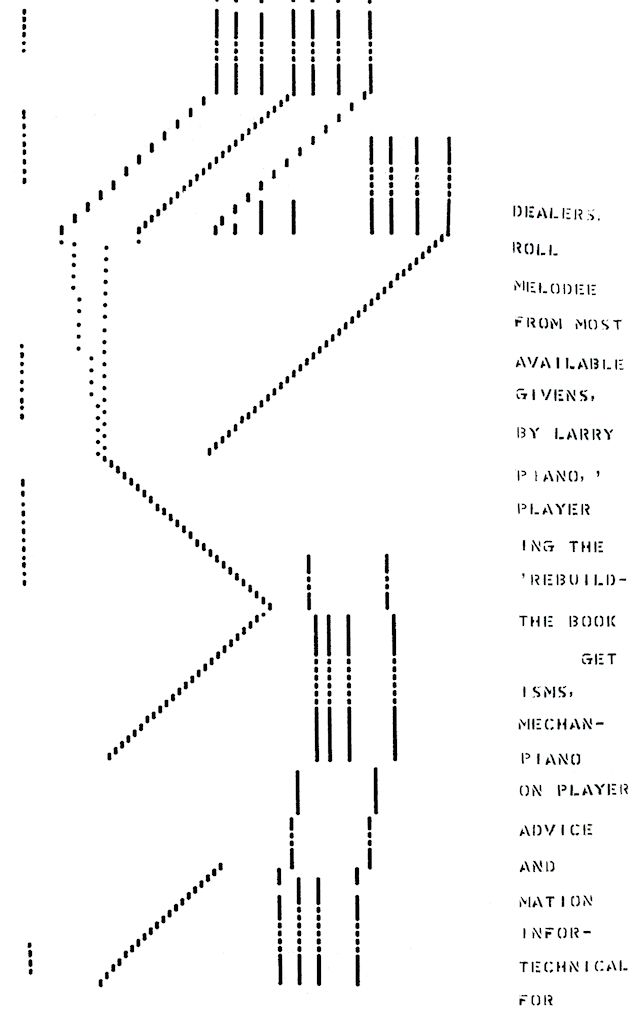 FOR TECHNICAL INFORMATION AND ADVICE ON PLAYER PIANO MECHANISMS, GET THE BOOK 'REBUILDING THE PLAYER PIANO', BY LARRY GIVENS, AVAILABLE FROM MOST MELODEE ROLL DEALERS. There are a few things that we find interesting about this particular comment and this portion of the roll. Obviously, this is an advertisement for Larry's book. However, from an historical viewpoint, it helps date the test roll because Larry's book was first published in 1963. So, the roll had to have been produced sometime after the book was published. The point being that ALL of the other test rolls we've ever seen were originally produced before 1935. Therefore, it's our opinion that Mel-O-Dee was motivate to produce their test roll because they thought that all previous 88-note test rolls were lacking to some extent, and they felt that they could make one that was better than the rest. Below is a screen-shot from the MIDI file of the entire first portion of the test. Also, here is what it should sound like -click here. This portion of the test ends with the largest chord in the test roll. Sixteen notes are played simultaneously. Shortly after the notes are played, the automatic sustaining pedal is activated, and it stays on until just after the perforations have ended. While this portion of the roll isn't part of the Capacity Test, it's interesting to note that the only other time sixteen notes are played simultaneously is near the end of the portion of the Capacity Test that plays the marimba notes.
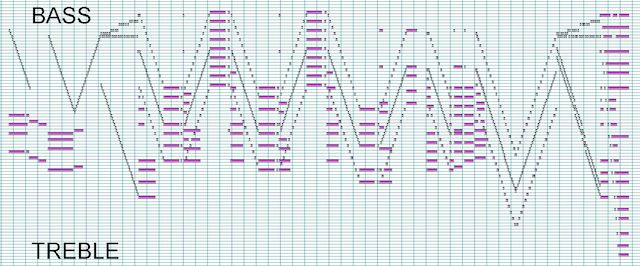 The second portion of the Musicality Test is more challenging than the first portion. First, it plays a large number of staccato notes all the way across the keyboard. At the very end of this section, the automatic sustaining pedal is activated and eight staccato notes are played. However, the pedal is turned Off just before the first chord in the next section is played. Again, the purpose of this action is to check the speed at which the pedal turns Off. Next, the same notes that were played in the first section are played again, but with longer note durations. Also, interspersed in this section are other melody notes which, while very short in duration, you should be able to hear. At the same time, the pedal is being turned On and Off. The purpose here is to discover if the notes get muddled by the actions of the pedal. The last portion of the test plays chords in the middle register while playing the same staccato notes in the treble register that are two octaves higher. Meanwhile, the sustaining pedal comes On at the beginning of each chord and turns Off before the next chord is played. Here is what this portion of the roll should sound like -click here. Below is a screen-shop of what this portion looks like.
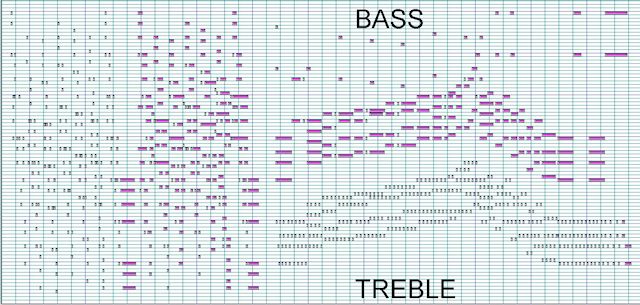 This concludes the explanation of the tests on the Mel-O-Dee Test Roll. To purchase the Mel-O-Dee Test Roll for $39.80, call 1-732-840-8787 or Click Here to fill out the Order Form. |

![]() ..To
The Top of this Page . . . . . . . . . . .
..To
The Top of this Page . . . . . . . . . . . ![]() ..To The HOME Page
..To The HOME Page
|
Since "Player-Care" is an internet business, I prefer that we correspond via E-Mail (click here to fill out the 'Request Form'). However, if I'm not in the middle of some other activity, you can reach me at 732-840-8787. But please understand that during the hours from 8AM-5PM EST (Mon-Sat), I'm generally quite busy. So, I probably won't answer the phone. If you get the answering machine, please leave a detailed message stating the reason for your call. Also, repeat your name and phone number clearly and distinctly. By necessity, I prioritize everything in my life. And, if you call and just leave your name and number, and ask me to call you back, it might be a day or two before I return your call. Why? Because I don't know why you want me to call and I might not be prepared to assist you in an effective and efficient manner. If you leave me an E-Mail address (which I prefer), spell it out phonetically. The more you do to help me, the more I can help you in return. Don't rush. You have four minutes to record your message. |
|
407 19th Ave, Brick, NJ, 08724 Phone Number 732-840-8787 (Voicemail Only, No Texts) |
